This was published 4 years ago
Fourth time’s a charm: Why is Victoria the nation’s lockdown capital?
By Tom Cowie and Liam Mannix
Is it contact tracing? A more virulent virus? Maybe it’s the colder climate? Perhaps Melbourne is too easy to get around? Or is it just bad luck?
Victoria is in the middle of its fourth lockdown since the COVID-19 pandemic began, prompting some of us to wonder why one state has been forced to shut down more than any other in the past year.
This time, a slow vaccination rollout has coincided with the now-familiar explanation of a breach in hotel quarantine.
However, other states have brought community transmission under control without imposing recurring statewide lockdowns like Victoria has.
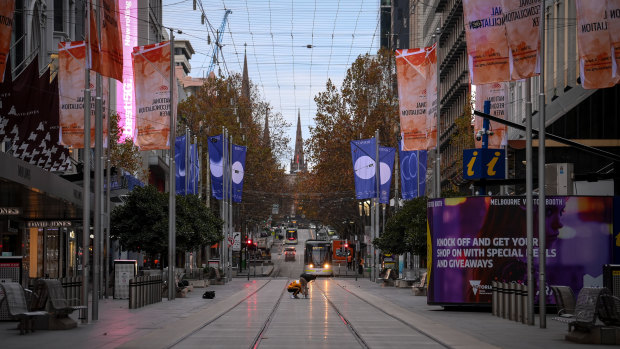
Melbourne was deserted on the first day of winter.Credit: Eddie Jim
NSW has provided the clearest difference. The nation’s biggest state has managed to keep a lid on several outbreaks while staying open. The closest it came was in December when the northern beaches cluster reached 38 and a localised lockdown was introduced.
Restrictions were also placed on the rest of Sydney. However, a statewide stay-at-home order was avoided as that outbreak fizzled out after 151 cases.
Victoria, meanwhile, is now in its second lockdown of 2021, which followed two in 2020. There was the five-day lockdown in February after the Holiday Inn outbreak and then this latest lockdown, which is planned for seven days but could last longer.
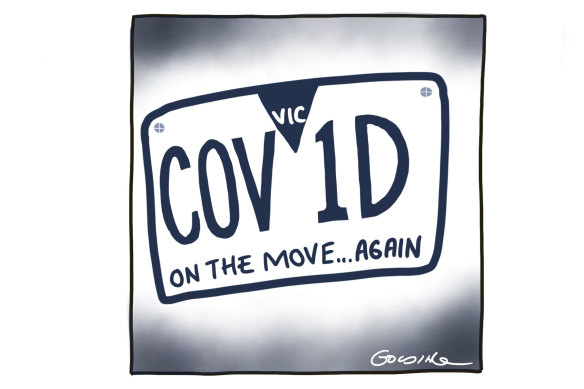
Age cartoonist Matt Golding’s view.Credit: Matt Golding.
South Australia is the only other place to plunge into a statewide hard lockdown after state authorities said a person lied about being a customer at a pizza shop where a worker had the virus.
Perth and Brisbane have also had short snap lockdowns following hotel quarantine breaches, however nothing like the 112-day lockdown that Melbourne endured last year.
Epidemiologist Professor Tony Blakely from the University of Melbourne said that poor contact tracing – a reason given for Victoria’s earlier lockdowns – no longer applied.
“The contact tracing going on in Victoria is phenomenal, it’s mind-blowing,” he said.
“The level of testing that we’re seeing in Victoria is phenomenal, they can’t be explanations for why it’s not going as well in Victoria.”
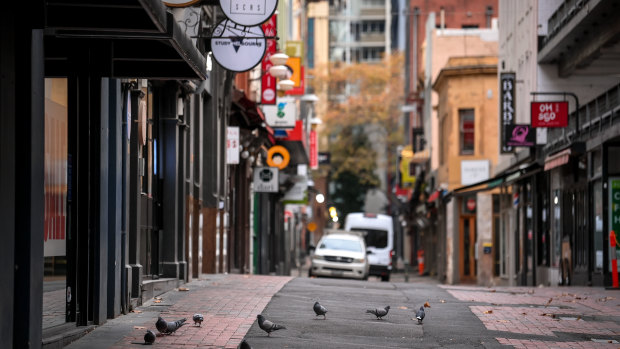
Melbourne in the middle of its fourth lockdown on June 1.Credit: Eddie Jim
That view was shared by Chief Medical Officer Paul Kelly, who told a Senate estimates committee on Tuesday that contact tracing had improved in Victoria.
“In contrast to last year, Victoria has been very rapid in its ... understanding of the outbreak,” he said.
The Victorian government has also defended its recent contact tracing efforts, citing the speed of transmission of the Indian variant of COVID-19 as a major factor for implementing the latest lockdown.
Professor Blakely said that the NSW approach of being slower to go into lockdown and quicker to come out would not be as successful with the latest variant.
Last year, the virus was spreading from one person to 2.5 people without any restrictions, he said. The Indian variant was closer to 3.5 or four, he said.
“We’re dealing with a more infectious virus,” he said.
Evidence from the UK suggests the variant is about as infectious as the British variant which led to Victoria’s lockdown in February.
Acting Premier James Merlino said last week that the virus was spreading from one person to another within 24 hours.
“Something that moves that quickly, I think other states would struggle with this, even NSW,” said Deakin University’s Professor Catherine Bennett.
While the Indian variant may be one explanation, there could be others too. One possible reason given for Victoria’s lockdown woes is the way people move about Melbourne.
The current list of more than 320 exposure sites includes locations all across the city, while postcode data shows there are active cases in Melbourne’s north, west and south-east.
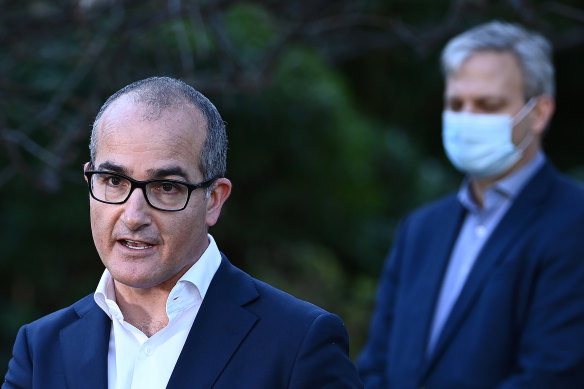
Victoria’s acting Premier, James Merlino, centre, has levelled blame for the state’s latest outbreak on the federal government.Credit: Getty
“In outbreak management, you have to look not just at the case numbers and the speed at which the cases are travelling, but also human behaviour and location,” said UNSW epidemiologist Professor Mary-Louise McLaws.
“Location is really important because in Victoria people are highly connected. It’s a city that is easy to get around. You have to take that into account. People travel widely.
“Sydney is highly congested, the public transport is patchy. And people often don’t like moving outside their work or home zone.”
Professor Blakely said Victoria’s colder climate could be another factor – although it wasn’t the only one.
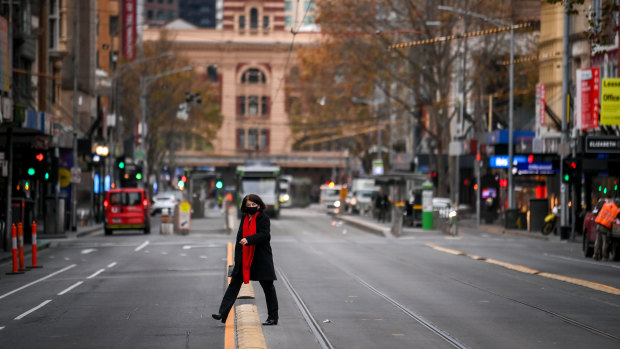
Victoria will be locked down for at least seven days.Credit: Eddie Jim
“It is reasonable to hypothesise that Victoria has different social movement patterns because of the way our city is laid out and a different climate means we’re inside more often,” Professor Blakely said.
“These things are possible but they’re not the whole part of it.”
Something that can’t easily be measured is the role chance has played. And Victoria has had plenty of bad luck.
For a start, the latest outbreak began after the virus spread in hotel quarantine in South Australia. And there is the matter of one of the earliest cases potentially being symptomatic in the community for 12 days before getting tested.
“There’s still this high chance variation, which is just how the virus plays out,” said Professor Blakely.
“Were you unlucky to have a super spreader who went to several suburbs? If all of those happen you’ve got dynamite on your hands.”
Another question is why authorities have chosen to lock down the entire state, rather than just metropolitan Melbourne.
Chief Health Officer Brett Sutton has said that doing so would mean people would try and escape restrictions by fleeing to regional Victoria.
The same logic appears to apply to localised lockdowns. Melbourne attempted to ring-fence specific suburbs last July, but it wasn’t successful.
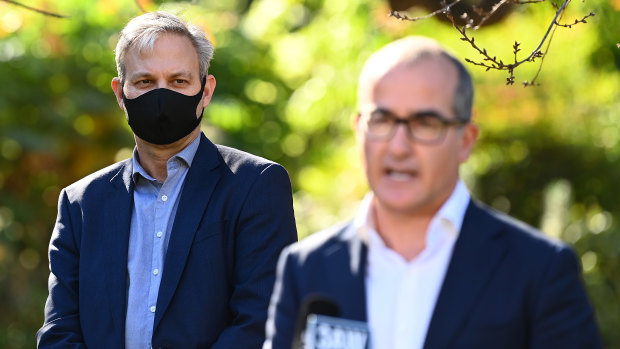
Chief Health Officer Brett Sutton (left) has said that people would try to escape restrictions if Melbourne was locked down.Credit: Getty
Asked at a media briefing on Monday why Victoria was the “capital for outbreaks and lockdowns”, Mr Merlino said it was an “unfair question”.
“Let’s remember that this outbreak that we are dealing with right now originated from a hotel quarantine breach in South Australia. That’s a fact,” he said.
“Now, I’ve said we would not be in this position, we would be in a very different world if we had a successful rollout of the Commonwealth’s vaccination program.
“It would be a very different world if we had alongside hotel quarantine, alternative quarantine arrangements for our highest risk cohorts that travel in from overseas. But we don’t have that.”
Stay across the most crucial developments related to the pandemic with the Coronavirus Update. Sign up for the weekly newsletter.